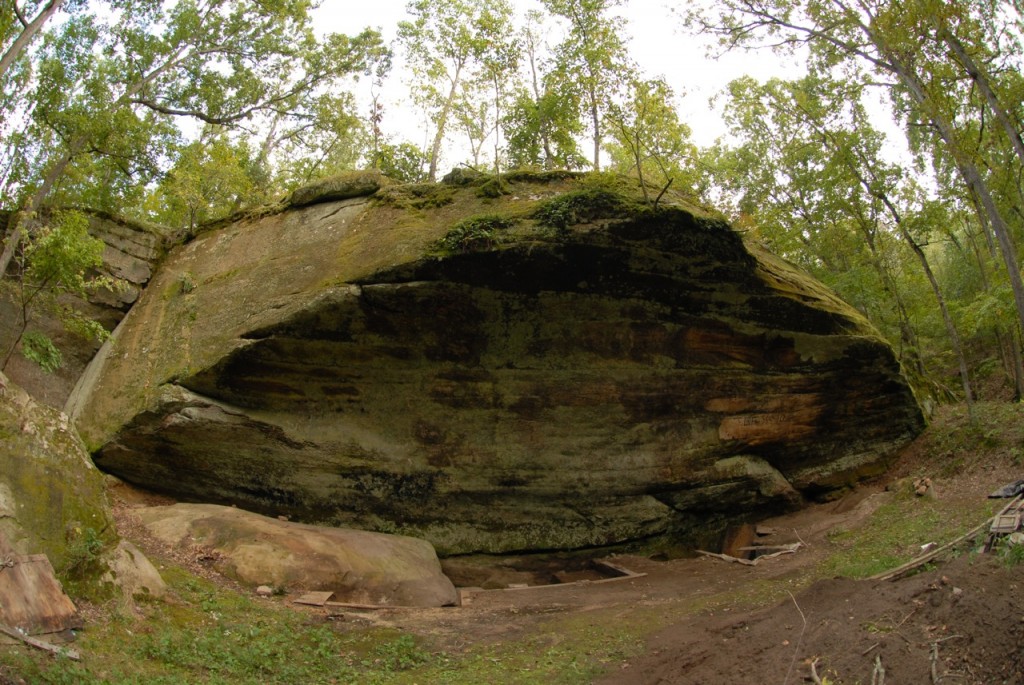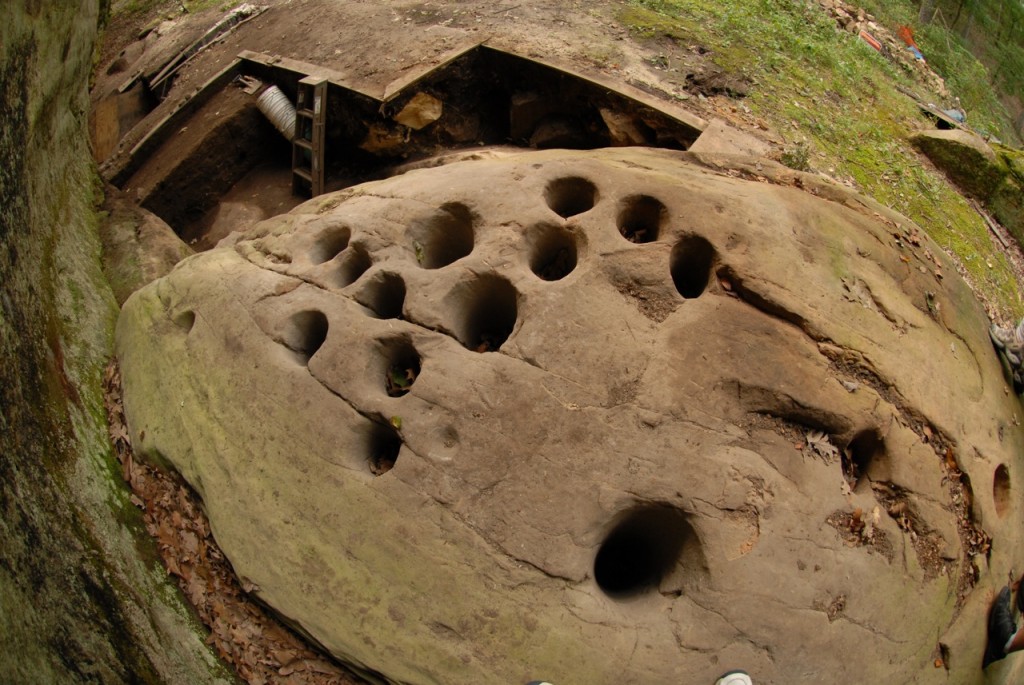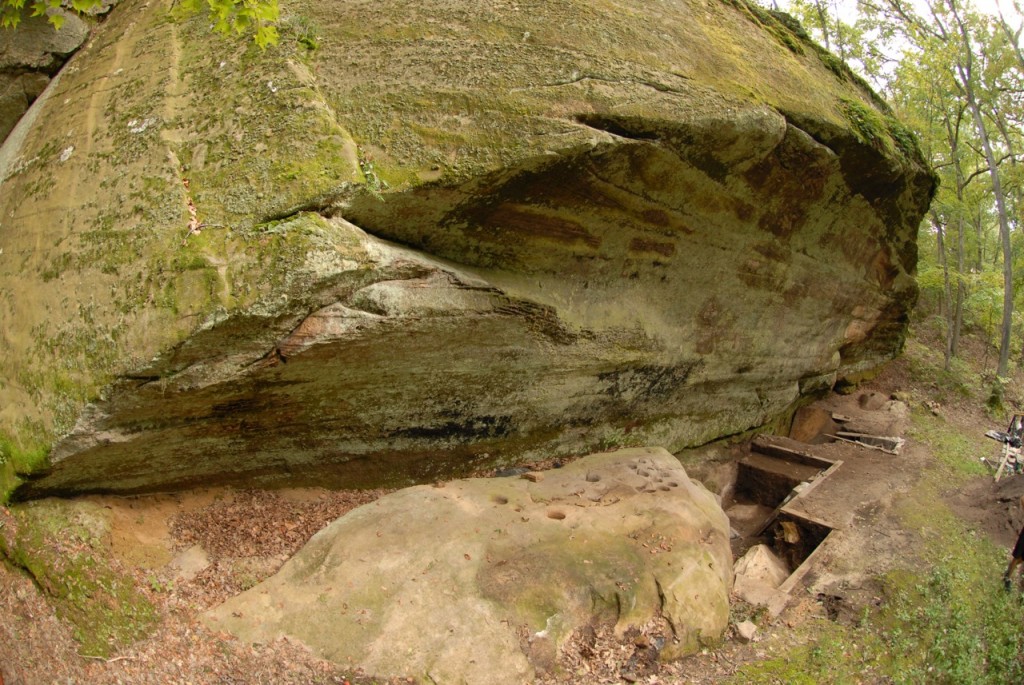Allscheid Rock Shelter Provides Glimpse of Mississippian Culture

Facing view of the Allscheid Rock Shelter and a portion of the archaeological excavations. Photo courtesy Sandra Schrock
Our area’s resource rich nature certainly was on full display during the first weekend of May as nearly 140 members of Illinois Audubon Society visited and were delighted with sightings of Cerulean warbler, American bittern, Sora, and many additional species.
During the first weekend of June, we can learn about the long history of human attraction to our bluff lands and uses of nearly unparalleled natural bounty. And, that history is a deep one, as Mel Allscheid wrote:
Eight thousand years ago…They came for the hickory nuts, perhaps, or the plentiful deer. They stayed for a few days or weeks, hunting deer for meat and hides, and harvesting and processing nuts into nut meal and nut oil. They returned the following spring, and the spring after that.
It was the sixth millennium before the Common Era, and this hollow in the cliff would be used on and off for the next 7,500 years.
The Allscheid Rock Shelter, 2013, Mel Allscheid and Brian Luhr
Detailed excavations and careful research at the Allscheid rock shelter add a great deal to our knowledge about early American cultures and the activities of people who used the site. The Allscheid site is of particular interest because it is a rare and very well preserved upland site, lending comparative value to studies of sites like Modoc, a larger Bottomlands site in Randolph County.

A large boulder with "hominy hole" excavations that may have been used for food or nut oil processing at the Allscheid Rock Shelter. Photo courtesy Sandra Schrock.
The very deep history of the site also provides clues to the beginnings of complex social networks that developed as horticulture and then agriculture succeeded the first halting steps in the development of plant domestication. Nearly innumerable questions swirl about how humans first learned the essential elements of plant use: what might be edible or might be toxic, even poisonous; experiments with processing possible foodstuffs to eliminate dangers; experiments with processing to use plant fibers to create additional tools or clothing; what might be stored for later use; and, eventually, trial and error in increasing the numbers and reliability of particular types of plants that provided beneficial uses.
‘They probably just watched to see what other animals ate and learned that way’ is a common response to the puzzle of early humans’ trial and error approach to resource exploitation. But only consider the woe and pain any of us would experience by ‘learning’ food use by following the example of Yellow-rumped warblers, opossums and raccoons feasting on the autumn-ripe white berries of plentiful poison-ivy plants. Or consider plucking and eating mushrooms and other fungi without the benefits of ‘poison / not-poison’ knowledge passed from one generation of morel lover to another, now neatly and readily available in photo-illustrated guides.
Even the first movements to gathering-hunting subsistence must have been halting and slow as early hominids gathered plant stuffs and scavenged carrion. Over millennia, domestication of wild plants yielded purposeful harvests and then purposeful planting, tending of fields, and reaping the bounty of agriculture. The process certainly was not one of constant progress and ever-increasing benefit. Archaeological studies and forensic evidence of bone-growth rings show the first development of malnutrition and repeated periodic starvation events among early agriculturalists.

Another view of the shelter. Archaeological research established that Native American peoples visited and used the site periodically beginning about 8,000 years ago. Photo courtesy Sandra Schrock.
Agriculture and its attendant complex hierarchical social structure developed at Cahokia Mounds, a Native American city located in what would become St. Clair County. Cahokia Mounds is the well-researched and best-known archaeological site of Mississippian culture that flourished from 600 to 1300 Current Era. Pottery and projectile points found at the Allscheid site indicate that the people who used the site had connections with the peoples of Cahokia Mounds. Very little is known about the depth and breadth of these connections, and no definitive proof exists of kinship linkages or even how deeply trading networks can be inferred from similarity of style and design among artifacts.
Unlike Cahokia Mounds, the Allscheid shelter seems to have never been a permanent year-round settlement site; rather, it was visited and used at various times and at differing levels of intensity. The Allscheid shelter and its artifacts continue to pose new questions about the development of tools kits for resource exploitation by early Native Americans. One such question is the possible use of excavated holes made in several large boulders found at the site. Among the possible answers to the questions about use are: grinding areas, fire-holding wells, or nut-oil processing. As is the case in much research, the site provides evidence but each piece of new knowledge also poses new and fascinating questions.
Some of these questions and the shelter that inspires them will be the focus of an upcoming Clifftop event as the Allscheid family has graciously offered a special field trip to view the Allscheid Rock Shelter. The field trip will take place from 9:30 am to noon on Saturday 6 June. The field trip is free and open to the public, but it is limited to 40 participants, and all must be 18 years of age or older. Registration must be made no later than 1 June; registrations can be made by emailing Clifftop@htc.net or by telephone, 618-458-4674.
CLIFFTOP, a local nonprofit organization, is focused on preserving and protecting area bluff lands.
A version of this article appeared in the 15 May 2015 edition of the Monroe County Independent.
© 2015 all content rights reserved Clifftop NFP
Comments are currently closed.
